Algeria 2020 "Archaeological sites"
| <prev | back to index | next> |
| Issue Date | 25.01.2020 |
| ID | Michel: ; Scott: 1800-1802; Stanley Gibbons: 1963-1965; Yvert: 1859-1862; Category: pF |
| Designer | Tayeb Laidi and Ali Kerbouche |
| Stamps in set | 3 |
| Value |
AD 25- Site of Ain Al Hanesh - Setif AD 25- Rocky art of the Sfissifa Station - Al Ghicha - Laghouat AD 25- Mosque of Abu Al Muhajir Dinar - Mila |
| Emission/Type | Commemorative |
| Issue place | Oran (Wahran) |
| Size (width x height) | 43mm x 29mm |
| Layout | |
| Products | FDC x1 |
| Paper | |
| Gum type | Mint |
| Perforation | 13.25 x 13 |
| Print Technique | Offset |
| Printed by | Printing House of the Bank of Algeria |
| Quantity | |
| Issuing Authority | Algérie Poste |
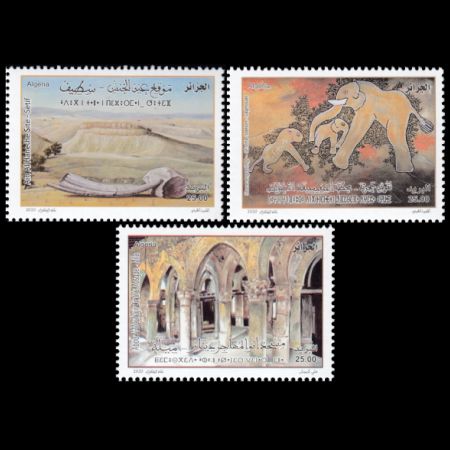
On January 15th, 2020, Post Authority of Algeria issued a set of 3 commemorative stamps that shows three unique archaeological sites of the country.
One of them shows petrified wood and a fossilized tusk of a prehistoric elephant that roamed in the area of Ain Al Hanesh over 2 million years ago.
Another stamp shows an adult and baby elephant attacked by a tiger from a cave painting at Sfissifa Station.
The following text is from official information brochure.
Site of Ain Al Hanesh - Setif
Archeologists have discovered lithic tools and animal bones at the site of Ain Al Hanesh, dating from 2.4 million years ago. The site is situated at the municipality of GueltaZerka, district of El Eulma, in the wilaya of Setif, 35 km from the chief town of the wilaya.
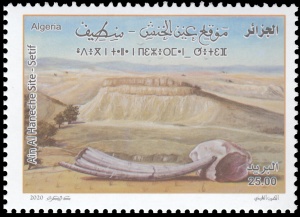 |
| A petrified wood and a fossilized tusk of prehistoric elephant on stamp of Algeria 2020. MiNr.:, Scott: 1801 |
In 1947, the French Paleontologist, Camile Arambourg resumed these studies and confirmed that the site was Plio-pleistocene in age. He classified the fossilized bones found including elephants, equids, cows, hippopotamus, rhinos, etc. He also observed cut pebbles that were interpreted as Oldowan sub-spheroidal and spheroidal polyhedrons. These pebbles were called by Lionel Balout as "The Spherical Round Utensils". These discoveries are some of the first found with both archaeological remains and the fossilized bones of Savannah animals.
By the beginning of the nineties, various annual researches and scientific excavations were programmed in order to decipher this site's mysteries and distinguish the link between it and hominids. In this spirit, a group of researchers led by the quaternary researcher and prehistorian Dr. Mohamed Sahnouni, launched their study of Lithic tools exhibited at the Musee de l'Homme of Paris, which were brought from the excavation of Camille Arambourg. These tools were compared to the Lithic tools discovered in Ain Al Hanech and those belonging to the site of Olduvai in Tanzania (East Africa).
Scientists consider this site of Olduvai to be the world's most ancient archaeological site inprehistory, where discovered fossilized remains of Homo habilis, why it was dubbed "The Cradle of Humanity". The discovery gave the site of Ain Al Hanech a major importance concerning the migration of hominoids from Africa to Europe and the early colonization of North Africa. That's why it's considered to be a key for future studies of the prehistoric era.
Rocky art of the Sfissifa Station - Al Ghicha - Laghouat
Primitive humans have always shown an interest in their natural environment, which they benefited from and used in their daily life, captured and illustrated through drawings and engravings, they put on the rocky surfaces around them and which we can see nowadays in different sites all over the country.
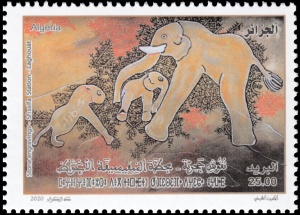
|
| Babe elephant attacked by a tiger from a cave painting at Sfissifa Station on stamp of Algeria 2020. MiNr.:, Scott: 1800. |
The station is located on the roadside, South of Al Ghicha municipality, and 10km away from its chief town. It holds one open facade taking the shape of a damaged rocky formation that weathered hazards have already devastated, and which is entirely exposed to the sun. Regarding this facade's dimensions, it has a length of 31,5m and a height of 7m, illustrating numerous animals: an elephant, a tiger, a baby elephant with an adult one, two ostriches, a donkey, a bull and a snake. This site is of significant archaeological value due to the drawings including a sketch of a female elephant protecting her calf. Due to the worldwide fame of the site and the iconic sketch, UNICEF (the United Nations International Children's Emergency Fund) has used the sketch for their emblem.
The drawing portrays a baby elephant in motion walking to the left side, protected by his mother. Put in the center of the facade and engraved in a thick and deep line, this drawing of 1.07m length and 1.85m wide is well preserved.
Products and associated philatelic items
| FDC | Example of Circulated Cover | |
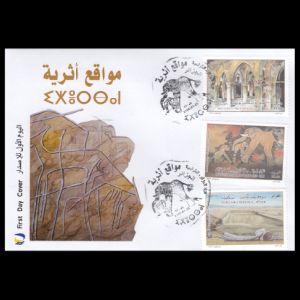 |
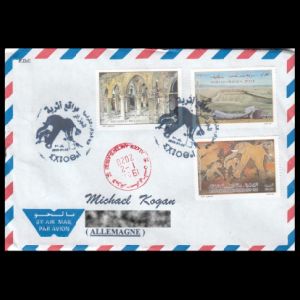 |
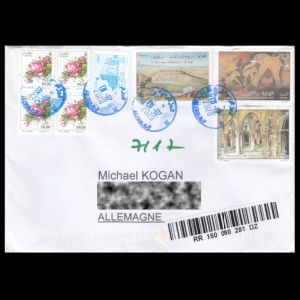 |
| Regular and registered letters sent to Germany | ||
| First-Day-of-Issue Postmark | ||
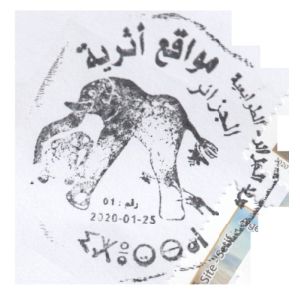 |
|
|

|
References:
Official information brochure (PDF file), WNS of UPU.Acknowledgements
Many thanks to Dr. Peter Voice from Department of Geological and Environmental Sciences, Western Michigan University, for reviewing the draft page .| <prev | back to index | next> |